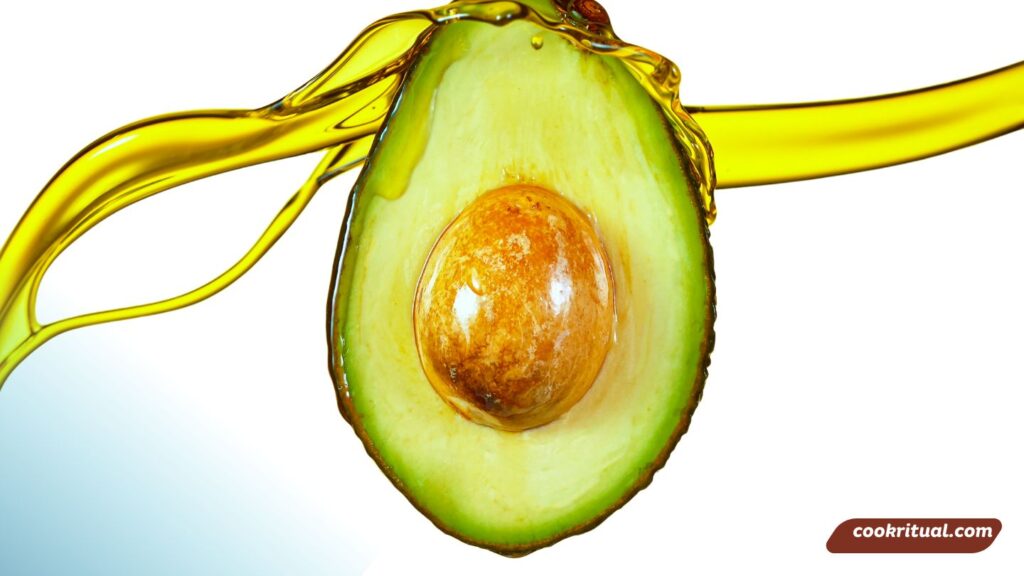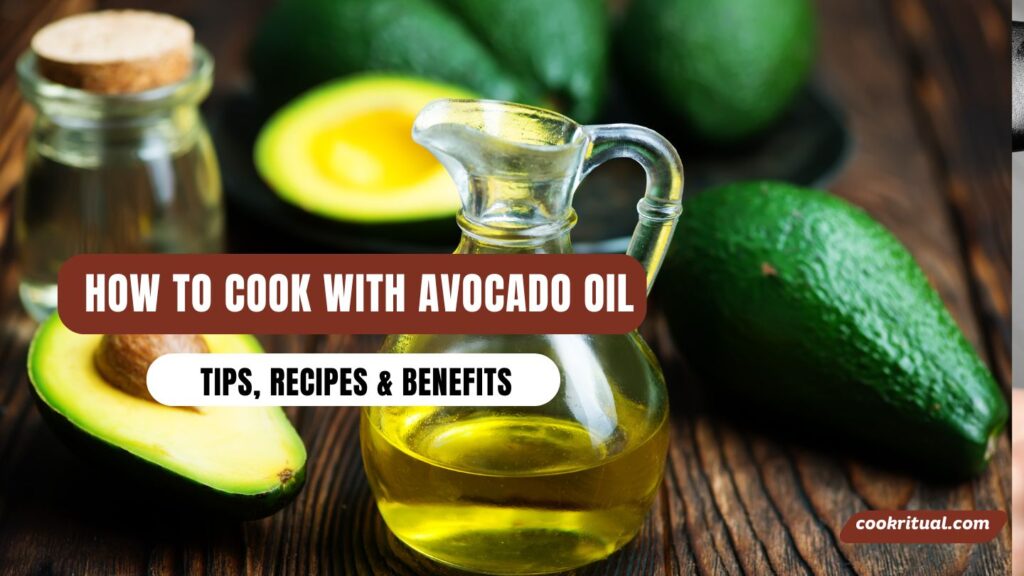Avocado oil is one of the healthiest and most versatile cooking oils available, making it a must-have in any health-conscious kitchen. Whether we’re whipping up a quick stir-fry after work or meal prepping for the week, avocado oil delivers a smooth, buttery flavor and stands up beautifully to high heat.
Many of us are trying to make smarter choices in the kitchen—cutting back on processed ingredients, choosing heart-healthy fats, and still making meals that taste amazing. That’s where avocado oil shines. Packed with monounsaturated fats, vitamins, and a sky-high smoke point, it’s not just a trendy oil—it’s a functional upgrade to our daily cooking routine.
In this guide, we’ll explore everything we need to know about cooking with avocado oil: from its nutritional benefits and smart usage tips to easy recipes and how it stacks up against other popular oils. We’ll also break down what kind of avocado oil to buy, how to store it, and answer common questions like “Can I fry with it?” or “Is it better than olive oil?”
Contents
- 1 What Is Avocado Oil?
- 2 Health Benefits of Cooking with Avocado Oil
- 3 Cooking with Avocado Oil: Tips and Techniques
- 4 Avocado Oil Recipes to Try
- 5 How to Choose the Right Avocado Oil
- 6 Storage and Shelf Life
- 7 Avocado Oil vs Other Cooking Oils
- 8 Common FAQs about Cooking with Avocado Oil
- 9 Final Tips and Recommendations
What Is Avocado Oil?

Avocado oil comes from the pulp of ripe avocados. It’s one of the few cooking oils that isn’t made from seeds. This makes it unique—and packed with flavor and nutrients.
How It’s Made
There are two main ways to make avocado oil:
- Cold-pressed: This method keeps more nutrients. It’s best for dressings and dips.
- Refined: This version has a higher smoke point. It’s ideal for high-heat cooking.
When shopping, we look for cold-pressed avocado oil when we want flavor and nutrients. For grilling or frying, refined is the way to go.
Nutritional Profile
Avocado oil is rich in:
- Monounsaturated fats (like oleic acid)
- Vitamin E
- Lutein (an antioxidant that supports eye health)
- Small amounts of potassium and magnesium
It’s also free of trans fats and low in saturated fat. That makes it a great fit for heart-healthy diets.
How It Compares to Other Oils
Let’s look at how avocado oil stacks up against some common cooking oils:
| Oil Type | Smoke Point (°F) | Best Use | Flavor |
| Avocado Oil | 480–520°F | Searing, frying, baking | Mild, buttery |
| Olive Oil (Extra Virgin) | 375°F | Dressings, light sautéing | Bold, fruity |
| Coconut Oil | 350°F | Baking, light frying | Sweet, nutty |
| Canola Oil | 400°F | Sautéing, frying | Neutral |
Source: Cleveland Clinic
Health Benefits of Cooking with Avocado Oil
We love avocado oil not just for its taste but also for its amazing health perks. Here’s why it deserves a spot in every kitchen.
Heart-Healthy Fats
Avocado oil is loaded with monounsaturated fats. These fats are known to:
- Lower “bad” LDL cholesterol
- Raise “good” HDL cholesterol
- Support heart health
According to Harvard Health, replacing saturated fats with unsaturated fats can reduce heart disease risk.
Packed with Antioxidants
It’s high in Vitamin E and lutein, which help:
- Protect cells from damage
- Keep skin and eyes healthy
Helps Absorb Nutrients
Some vitamins, like A, D, E, and K, need fat to be absorbed. Cooking with avocado oil helps our bodies soak up more of these nutrients, especially when we’re eating veggies.
Great for Anti-Inflammatory Diets
Avocado oil can help lower inflammation in the body. This is useful for people with arthritis or chronic pain.
Perfect for Special Diets
- Keto
- Paleo
- Whole30
- Gluten-free
It’s a clean, plant-based oil that fits into almost any healthy eating plan.
Cooking with Avocado Oil: Tips and Techniques

Cooking with avocado oil is easy once we know how to use it. Here are tips to make the most of it in the kitchen.
Understanding the Smoke Point
The smoke point is the temperature where oil starts to smoke and break down. That can give food a bitter taste—and lose nutrients. Avocado oil has one of the highest smoke points of all cooking oils, which makes it very stable for heat.
| Oil Type | Smoke Point |
| Avocado Oil | 480–520°F |
| Olive Oil | 375°F |
| Butter | 300°F |
We use refined avocado oil for stir-fries, grilling, and deep frying because it holds up well. For low-heat cooking or cold recipes, cold-pressed is perfect.
Best Uses for Avocado Oil
- Sautéing vegetables
- Frying eggs or meats
- Grilling chicken or fish
- Baking muffins or roasted nuts
- Making homemade dressings or marinades
It gives a rich, smooth flavor without overpowering the dish.
Cold vs. Hot Applications
Here’s when to use each type of avocado oil:
- Cold-pressed: Best for salad dressings, dips, and finishing oils
- Refined: Ideal for frying, roasting, and baking
We keep both in our kitchen. Cold-pressed for flavor, refined for function.
Avocado Oil Recipes to Try
Using avocado oil in recipes is one of the best ways to make meals taste great and stay healthy. Whether we’re short on time or cooking for the family, it’s a solid go-to.
Quick & Easy Recipes
1. Avocado Oil Scrambled Eggs
- Heat 1 tsp avocado oil in a nonstick pan
- Crack in 2 eggs and scramble until fluffy
- Add salt, pepper, and herbs to taste
2. Roasted Vegetables with Avocado Oil
- Toss chopped veggies with 2 tbsp avocado oil
- Add garlic, rosemary, salt, and pepper
- Roast at 425°F for 25–30 minutes
These dishes come together fast and taste amazing.
Advanced Recipes
1. Stir-Fried Chicken and Broccoli
- Cook chicken in avocado oil until golden
- Add broccoli and stir-fry sauce
- Serve over brown rice or quinoa
2. Avocado Oil-Based Salad Dressing
- ¼ cup avocado oil
- 2 tbsp apple cider vinegar
- 1 tsp Dijon mustard
- Mix well and drizzle over greens
Avocado oil helps all the flavors pop.
Healthy Snacks
1. Air-Fried Sweet Potato Fries
- Cut sweet potatoes into wedges
- Toss with avocado oil, paprika, and garlic powder
- Air fry at 400°F for 12–15 minutes
2. Avocado Oil Popcorn
- Heat 1 tbsp avocado oil in a pot
- Add ¼ cup popcorn kernels and cover
- Shake until popping stops
These snacks are light, crisp, and full of flavor.
How to Choose the Right Avocado Oil
With so many options on the shelf, it helps to know what we’re looking for. Here’s how to pick the right avocado oil for our kitchen.
Refined vs. Unrefined
- Refined: Light in color, high smoke point, neutral taste
- Unrefined (cold-pressed): Darker green, more flavor, more nutrients
Unrefined is best for dressings. Refined works well for high-heat cooking.
Organic and Cold-Pressed Options
Look for labels that say:
- “Cold-pressed” or “Extra Virgin”
- “USDA Organic”
- “Non-GMO”
These versions keep more of the oil’s natural goodness. According to USDA guidelines, organic oils must meet strict growing and processing standards.
Best Brands and Indicators
Top signs of quality:
- Comes in a dark glass bottle
- Labeled with harvest or expiration date
- Certified by trusted organizations (like NSF or USDA)
We check reviews and certifications to make smart picks.
Storage and Shelf Life
Avocado oil can go bad if we don’t store it right. Here’s how to keep it fresh and flavorful.
Proper Storage Tips
- Keep in a cool, dark place like a pantry
- Use a dark glass bottle to block light
- Always close the cap tight after use
Avoid heat, light, and air exposure. They speed up spoilage.
Signs of Rancid Oil
- Musty or crayon-like smell
- Bitter or sour taste
- Cloudy or thick texture
If it smells “off,” it’s time to toss it.
How Long Does Avocado Oil Last?
| Oil Type | Shelf Life (Unopened) | Shelf Life (Opened) |
| Refined | 12–18 months | 6–8 months |
| Unrefined | 9–12 months | 4–6 months |
Store it right and check the date to make sure it’s still good.
Avocado Oil vs Other Cooking Oils
It helps to compare oils when planning meals. Here’s a quick breakdown of how avocado oil measures up.
| Oil | Smoke Point | Flavor | Nutrient Value | Best Use |
| Avocado Oil | 480–520°F | Mild, buttery | High in monounsaturated fats | Frying, roasting, baking |
| Olive Oil | 375°F | Rich, fruity | High in antioxidants | Dressings, light sautéing |
| Coconut Oil | 350°F | Sweet, nutty | High in saturated fats | Baking, medium-heat frying |
| Vegetable Oil | 400°F | Neutral | Highly processed | General-purpose frying |
Learn more from this Harvard Health comparison of oils.
Avocado oil’s high smoke point and balanced taste make it the most versatile of the bunch.
Common FAQs about Cooking with Avocado Oil
Can I fry with avocado oil?
Yes! Avocado oil has a high smoke point (up to 520°F), which makes it ideal for frying. It stays stable and doesn’t break down.
Is avocado oil better than olive oil for cooking?
It depends. Avocado oil is better for high heat. Olive oil is great for salads and light cooking. Both are healthy choices.
Does avocado oil change the taste of food?
Nope! It has a mild, buttery flavor that blends well with almost anything. It won’t overpower your dish.
Is avocado oil good for baking?
Yes! It works well in muffins, breads, and cookies. Use it as a 1:1 swap for vegetable or canola oil.
Final Tips and Recommendations
Cooking with avocado oil is a simple way to boost both flavor and nutrition. Here’s what we recommend:
- Use refined avocado oil for roasting, frying, or grilling
- Use cold-pressed oil for dressings, dips, and finishing touches
- Store it right to keep it fresh longer
- Try it in your favorite recipes for a clean, healthy twist


